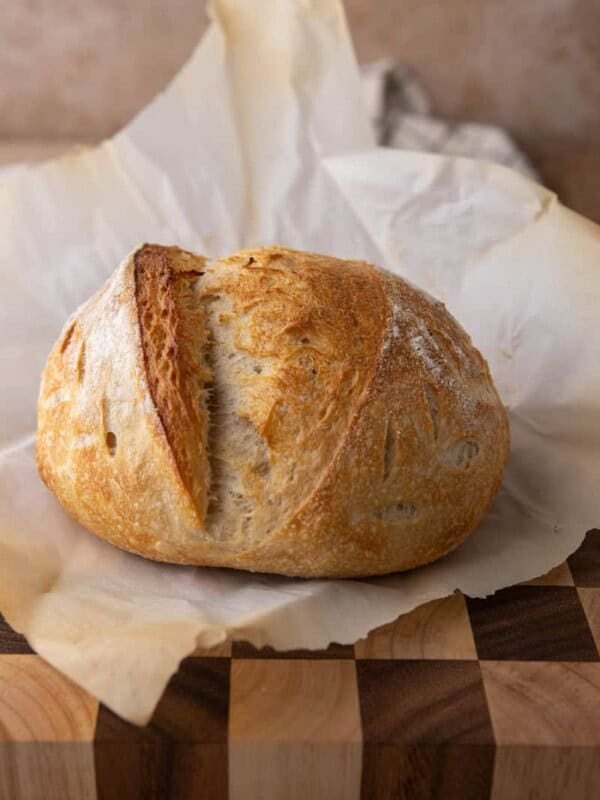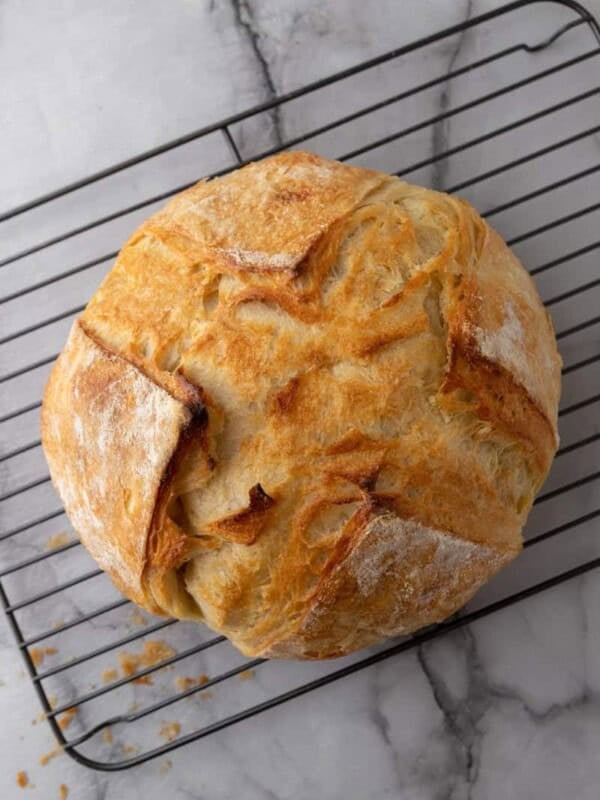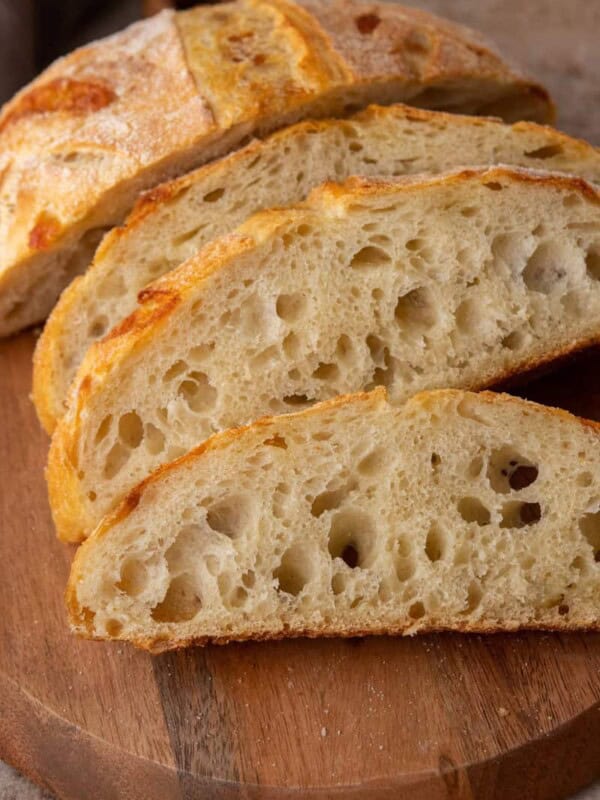This post may contain affiliate links. Please read our disclosure policy.
This Same Day Sourdough Bread recipe is a must-have page in every baker’s book. Made with a much shorter bulk fermentation process than usual, this same-day recipe saves the day and gives you fresh bread at any moment’s notice. So if you’ve ever wondered How to Make Sourdough in One Day, this is the guide for you!
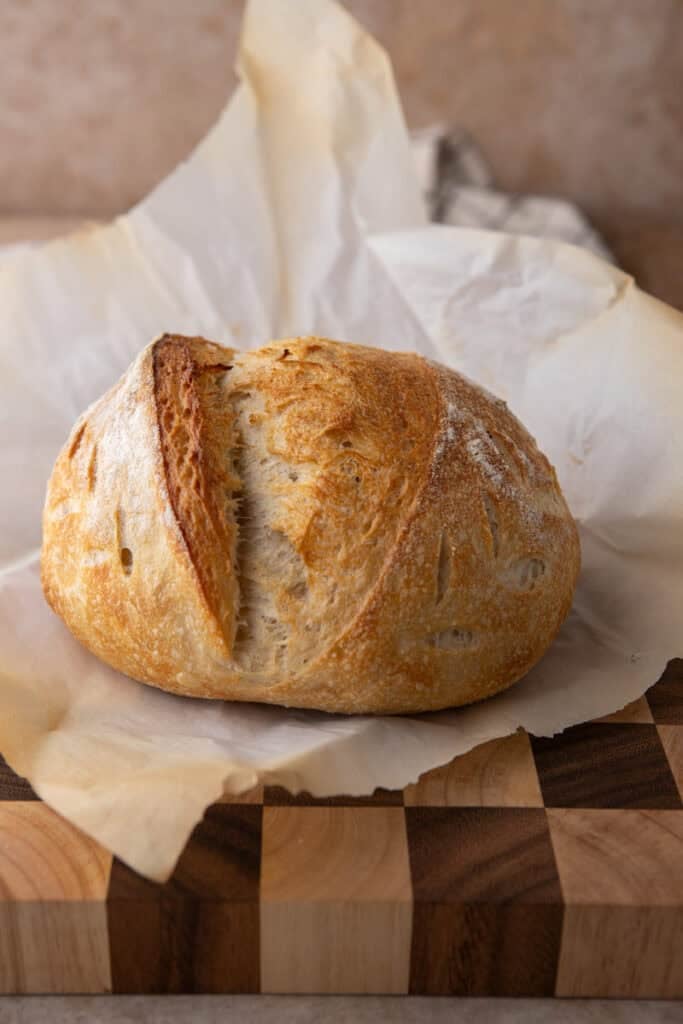
How is this bread made on the same day?
This recipe is basically a sped-up, quicker version of the classic sourdough process. Usually, making sourdough starts the day before and is left to ferment overnight to help the gluten and tangy flavor develop and become stronger. With this recipe, we do a much shorter rest time for the dough. You sacrifice a little bit of the potent sour flavor compared to the overnight recipe, but you still get great air bubbles and stretchiness in the dough due to the well-fed starter.
Why is this recipe useful?
It goes without saying that having to wait a whole 24 hours for your bread to be ready can be a pain and isn’t always convenient. This recipe comes in handy when you wake up in the morning with a craving for fresh bread, or when an unexpected event suddenly arises and you need something impressive on the day.
Since you are here and love sourdough recipes, check out this Starbucks Grilled Cheese Sandwich Copycat, this rosemary sourdough bread, this Dutch Apple Pie with Crumb Topping, this Family Style Dutch Baby Pancake Recipe, this Healthy no Sugar Added Banana Bread, or this Make Your Own Sourdough Starter Recipe.
Table of Contents
- How is this bread made on the same day?
- Why is this recipe useful?
- Ingredients for this Same-Day Sourdough Bread recipe
- How to make a Same Day Sourdough Bread recipe
- Simplified, Easy-to-Follow Schedule
- Same Day Sourdough Tips and Tricks for the best results
- Why do you need to make this same day sourdough recipe?
- Frequently asked questions – FAQ
- Same-Day Sourdough Bread Recipe
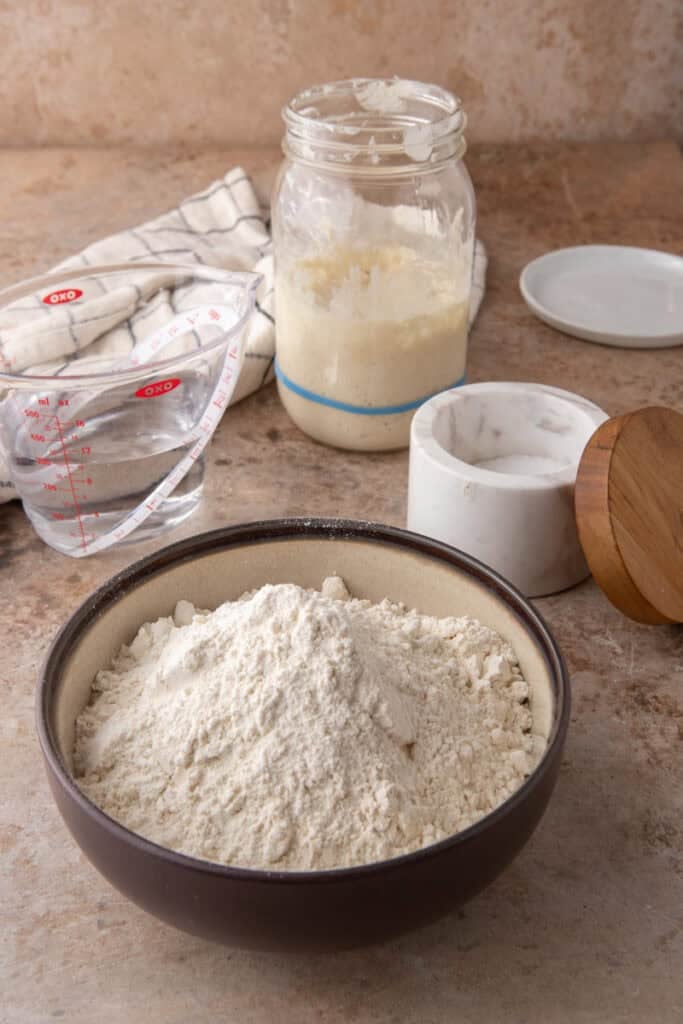
Ingredients for this Same-Day Sourdough Bread recipe
Here are the ingredients you will need to make this easy sourdough bread recipe. Scroll down to the recipe card at the bottom of the page for the detailed ingredient measurements.
- Bread Flour: provides high protein content for the structure and gluten needed. I love using this one!
- Water (room temp): hydrates the flour, activates gluten development, and helps the sourdough culture thrive during fermentation. Be sure to use filtered water instead of tap water.
- Active Sourdough Starter: is the natural leavening agent that gives the bread its rise and provides the signature tang. Want to learn more about how to make your own sourdough starter? Check out my guide!
- Salt: strengthens the gluten network and enhances the bread’s flavor.
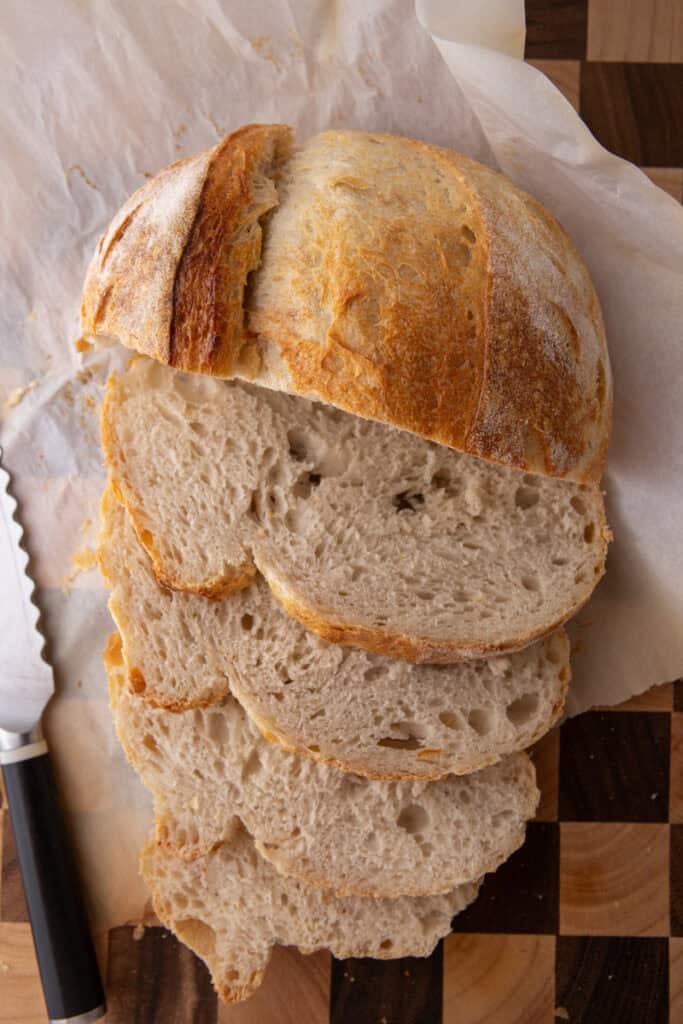
How to make a Same Day Sourdough Bread recipe
This is how you can make this 8-hour sourdough bread. Make sure to scroll down to the recipe card at the end of this post for the oven temperature, baking times, and complete step-by-step instructions!
Mix & Rest (Fermentolyse)
- Combine the bread flour, room temperature water, and active starter in a large bowl, stirring until there are no dry spots left.
- Cover the bowl and let the mixture rest for 30 minutes. This resting period activates key enzymes, begins gluten formation, and initiates fermentation.
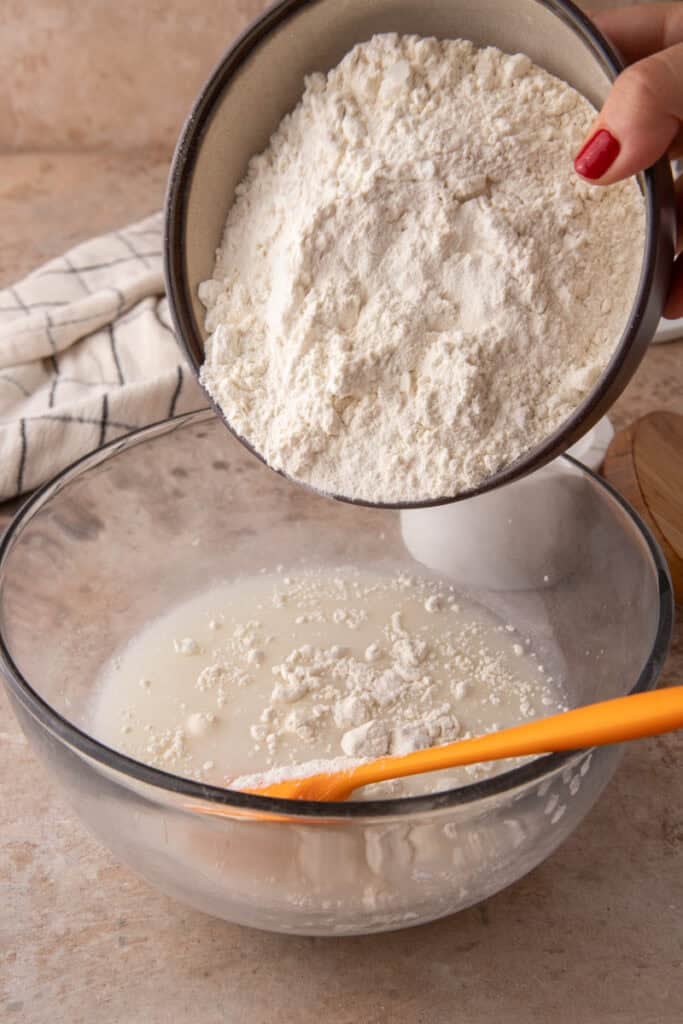
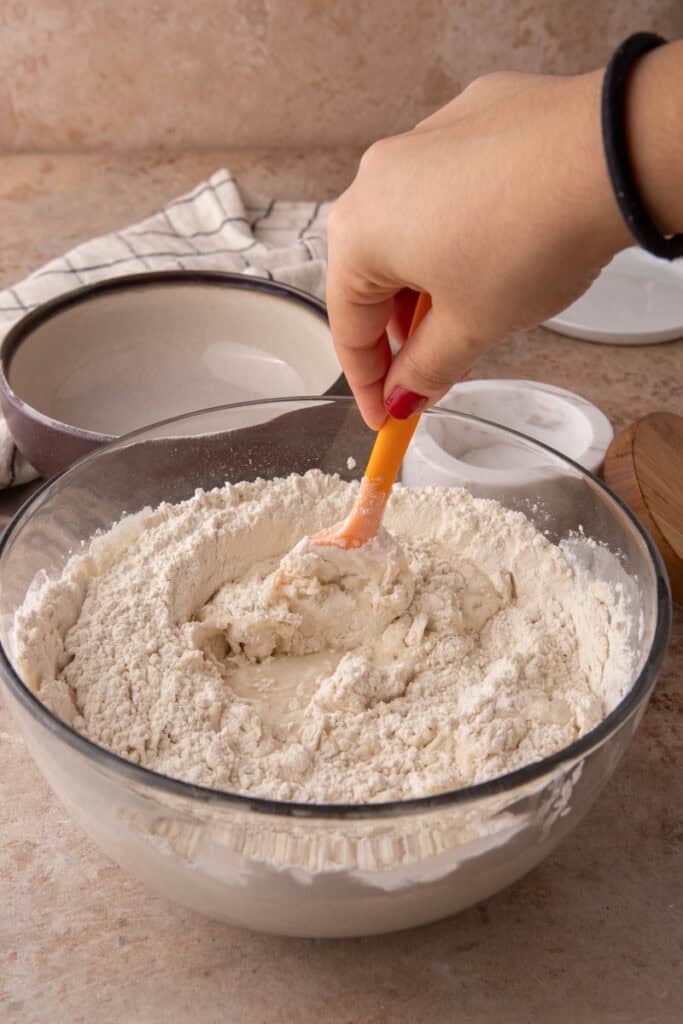
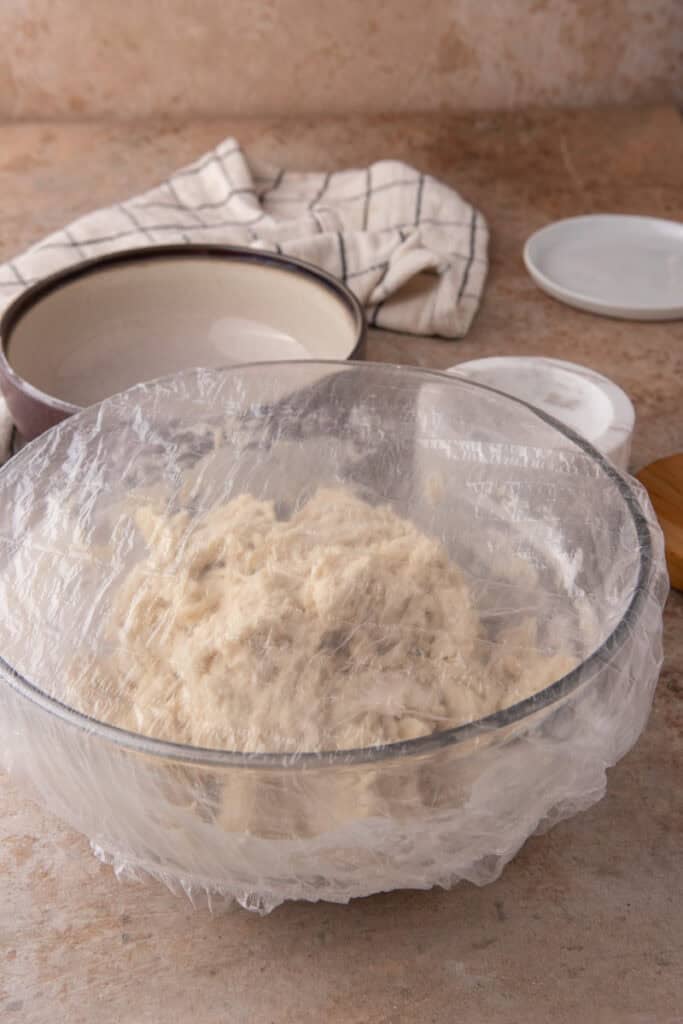
- Evenly scatter the salt over the dough and gently work it in using a pinch-and-fold or stretch-and-fold method. Let the dough rest for 10 minutes so the salt fully dissolves and integrates.
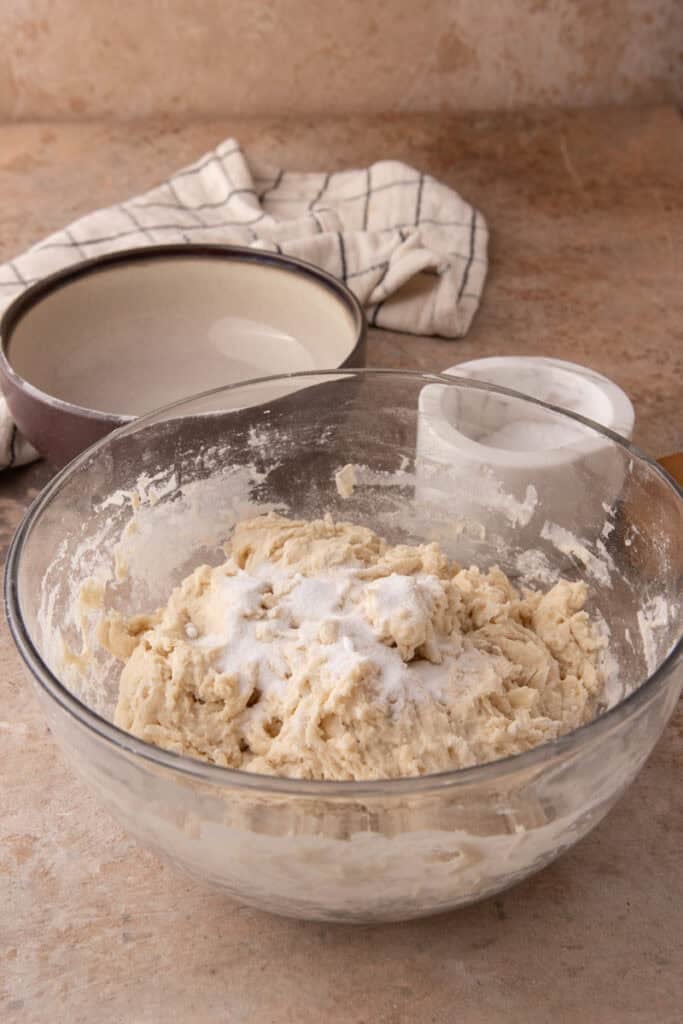
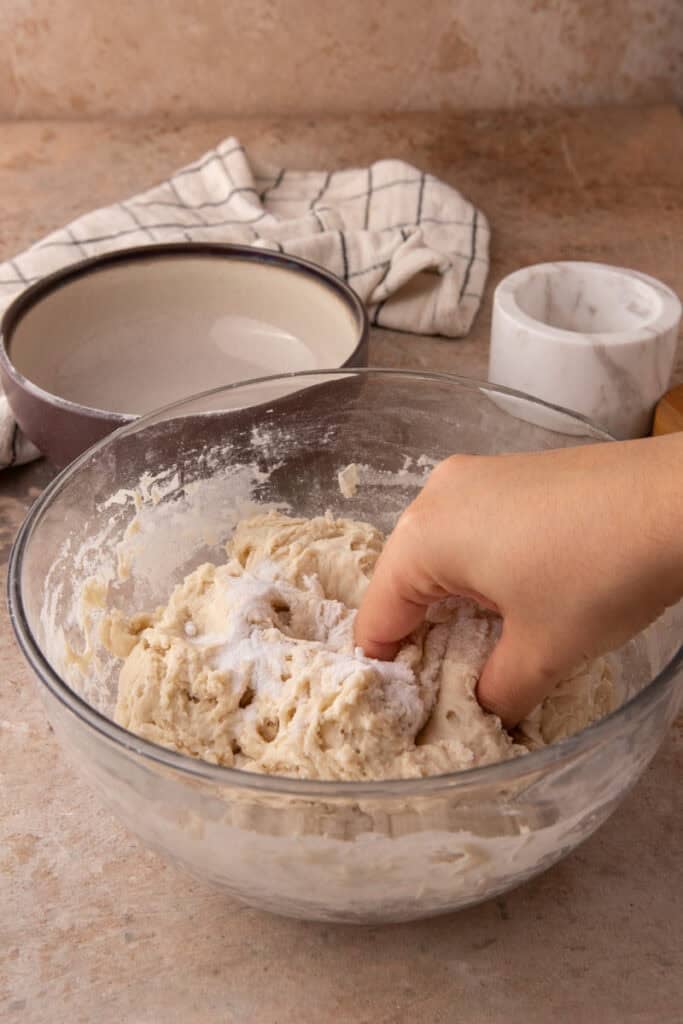
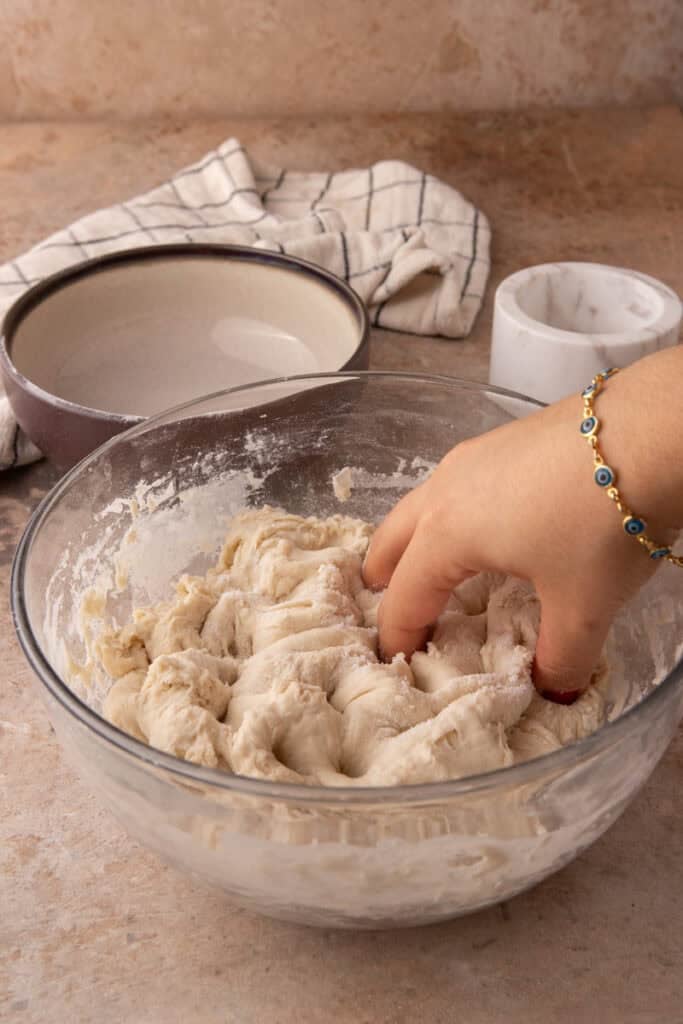
Bulk Fermentation
- Keep the dough covered and ferment it in a warm place throughout this step.
- For the first 90 minutes, perform three rounds of stretch and folds at 30-minute intervals. To stretch and fold, gently lift each side of the dough (north, south, east, and west) and fold it over toward the center.
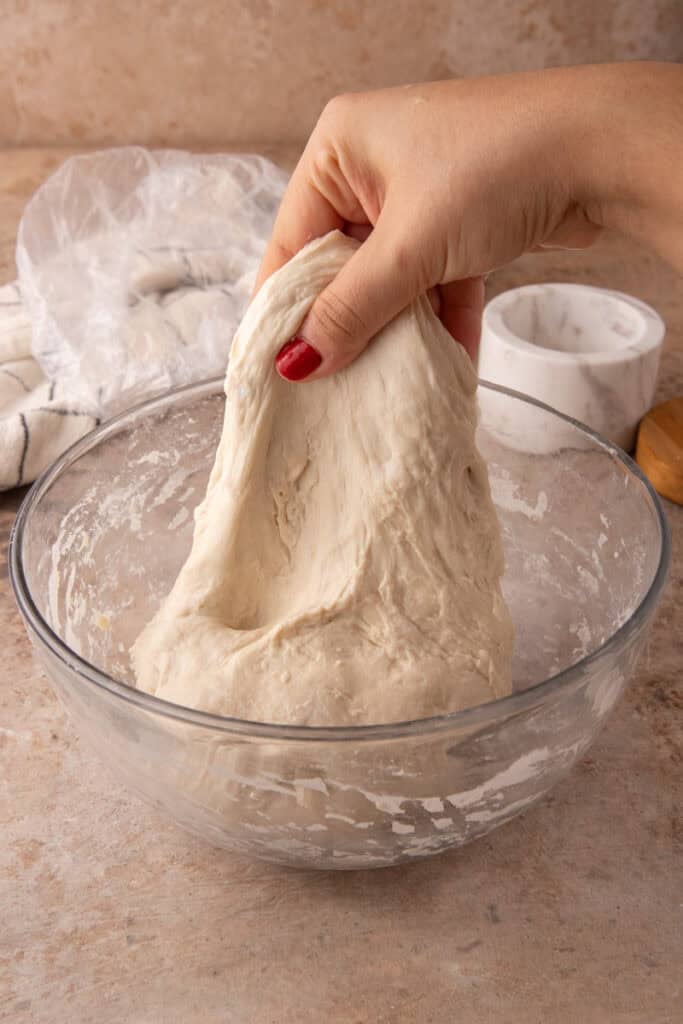
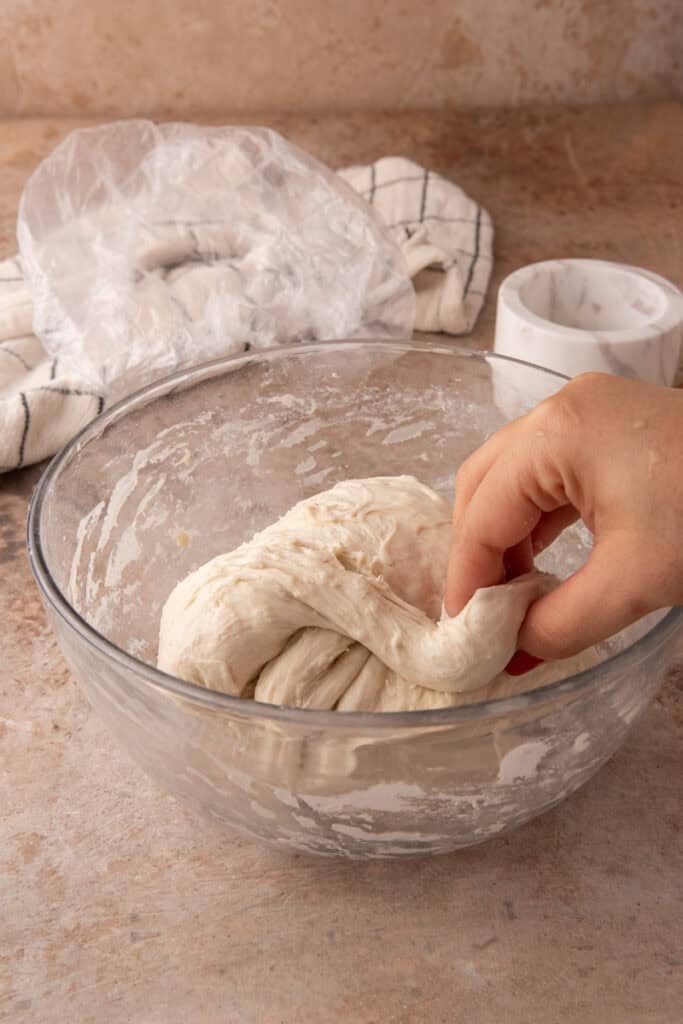
- After the three sets, cover and let the dough rise for 1-2 hours until it looks airy and has expanded by about 50%.
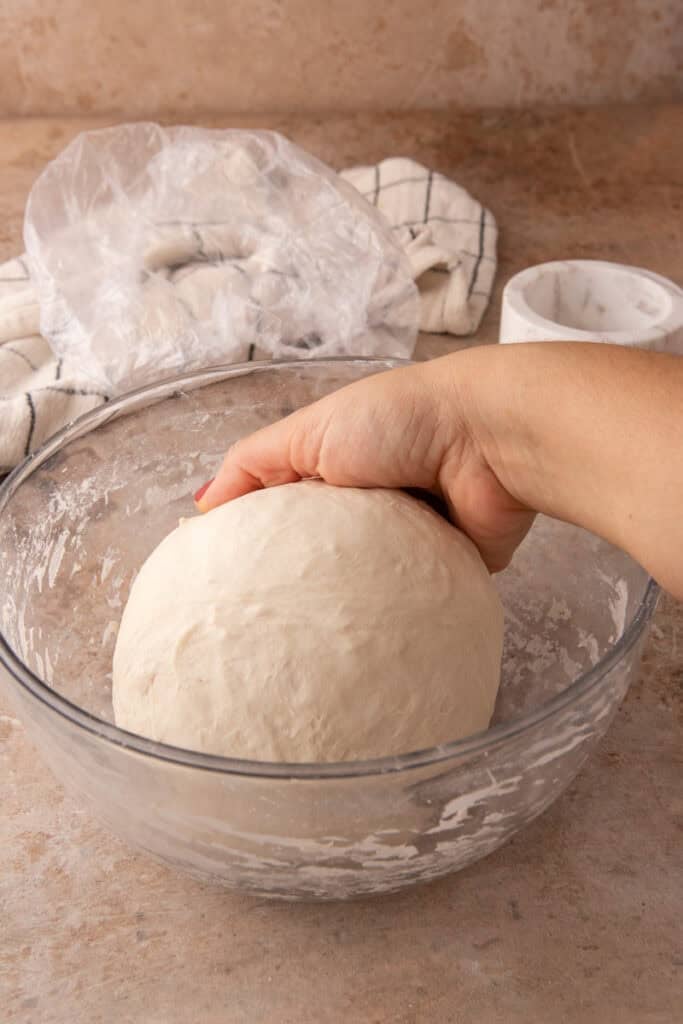
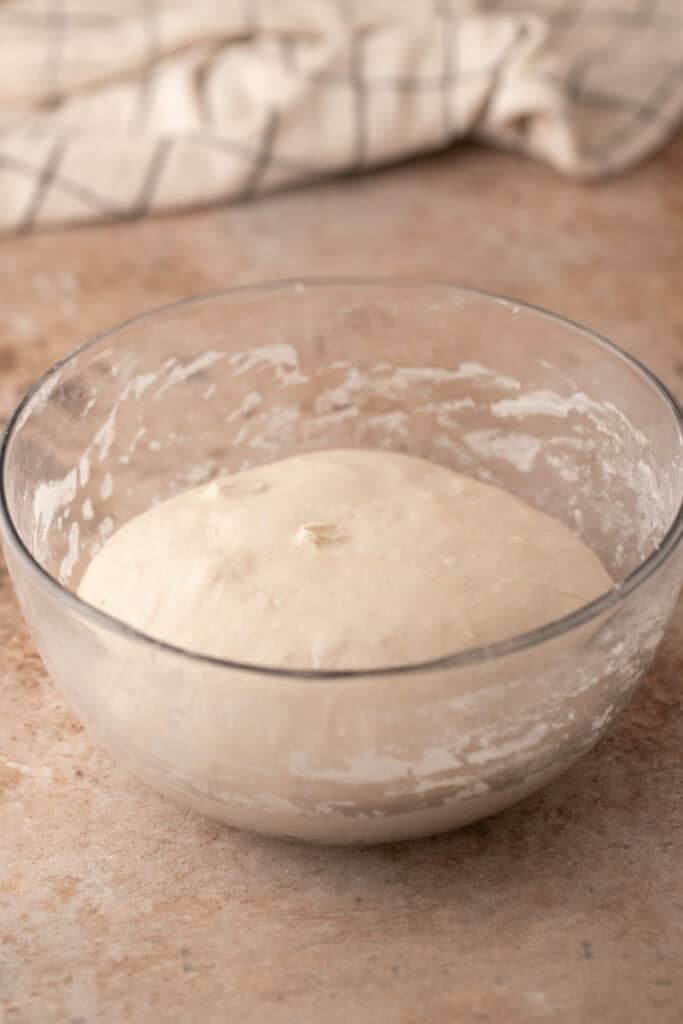
Pre-shape & Rest
- Turn the dough onto a lightly floured surface.
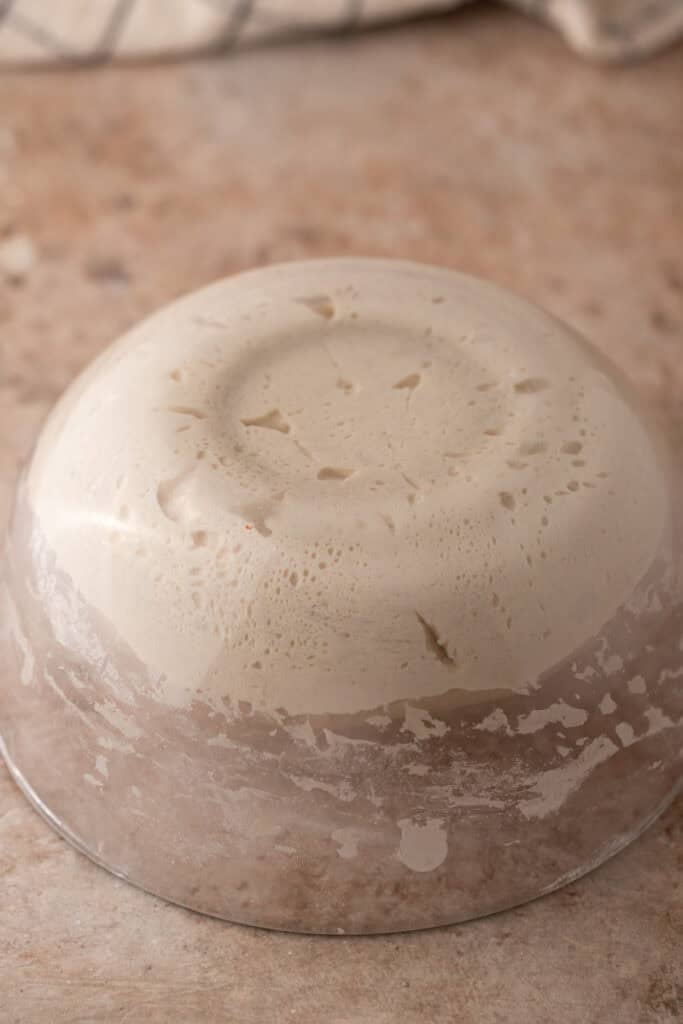
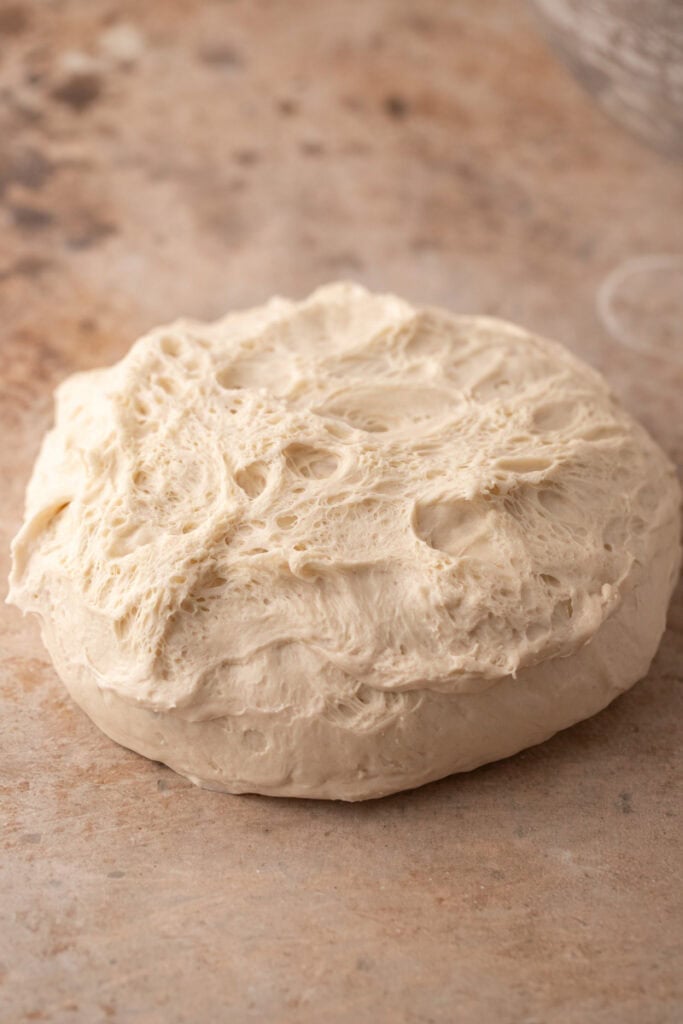
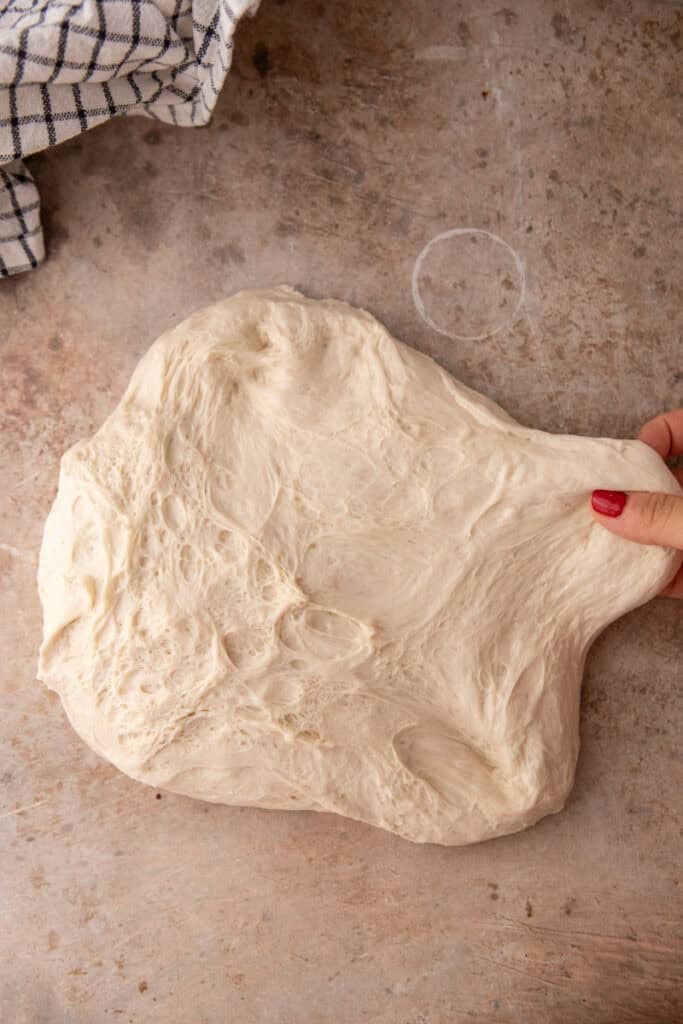
- Shape it loosely into a sourdough boule by lightly stretching and folding the dough into three horizontally. Next, roll it up vertically. It’s helpful to use a bench scraper.
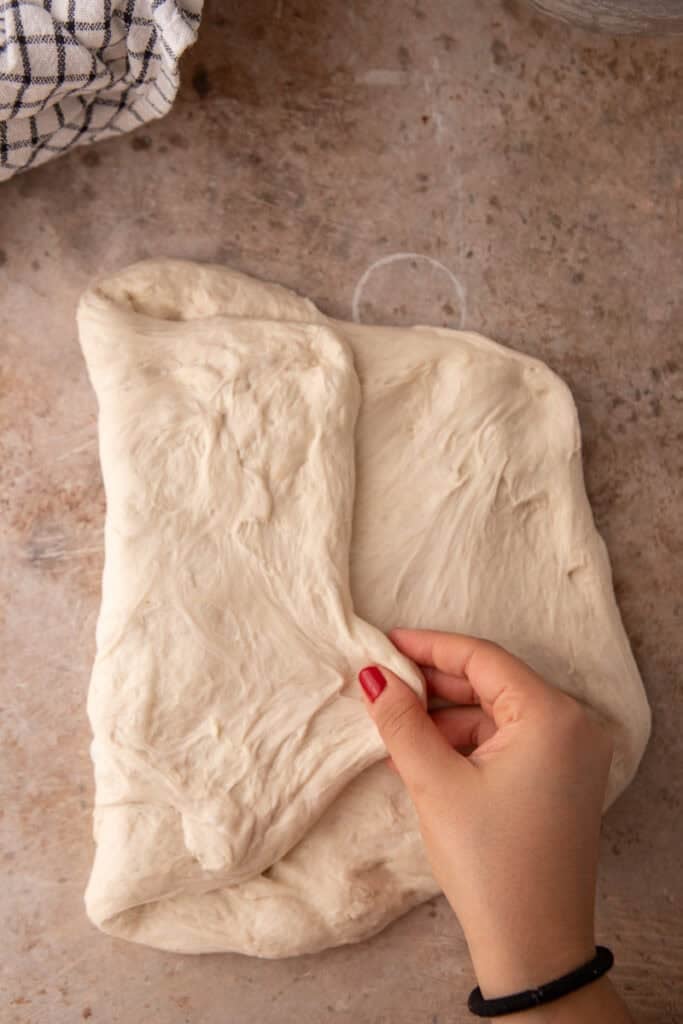
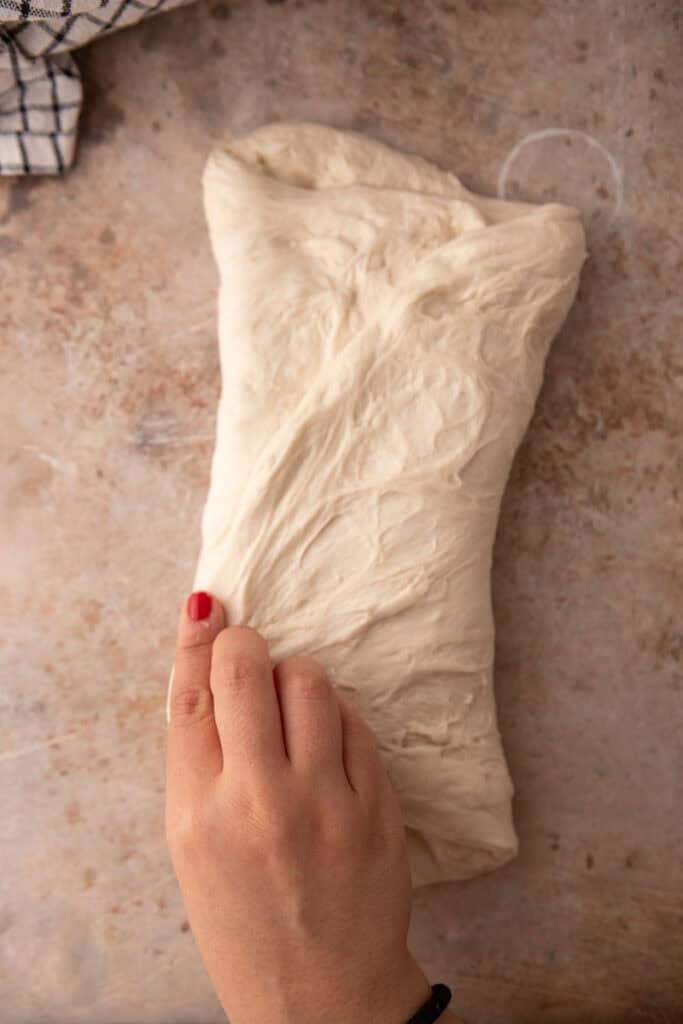
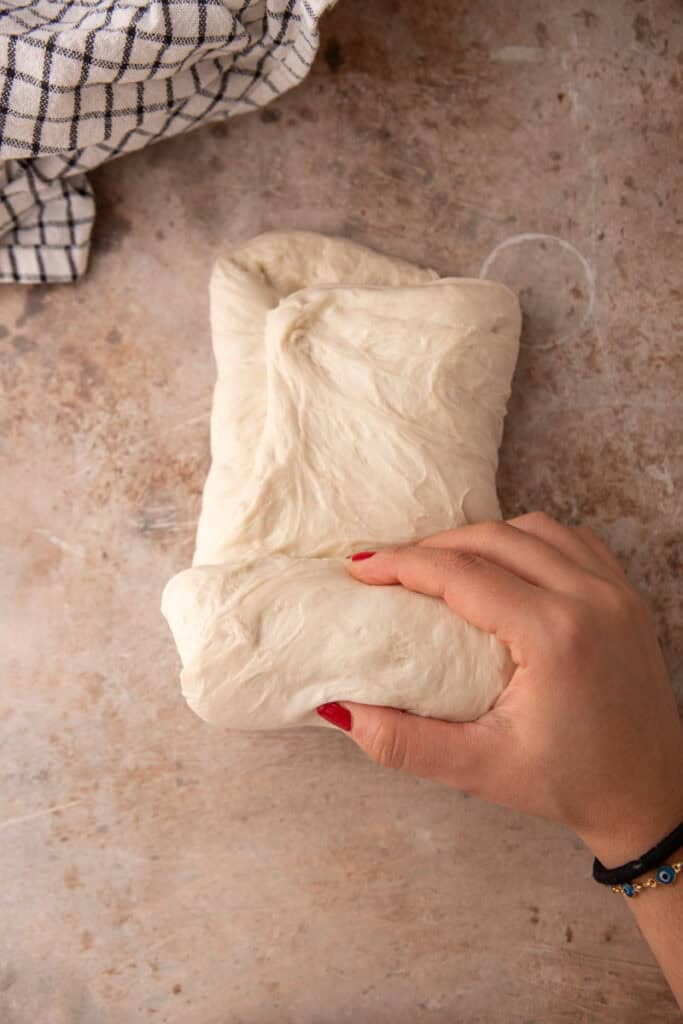
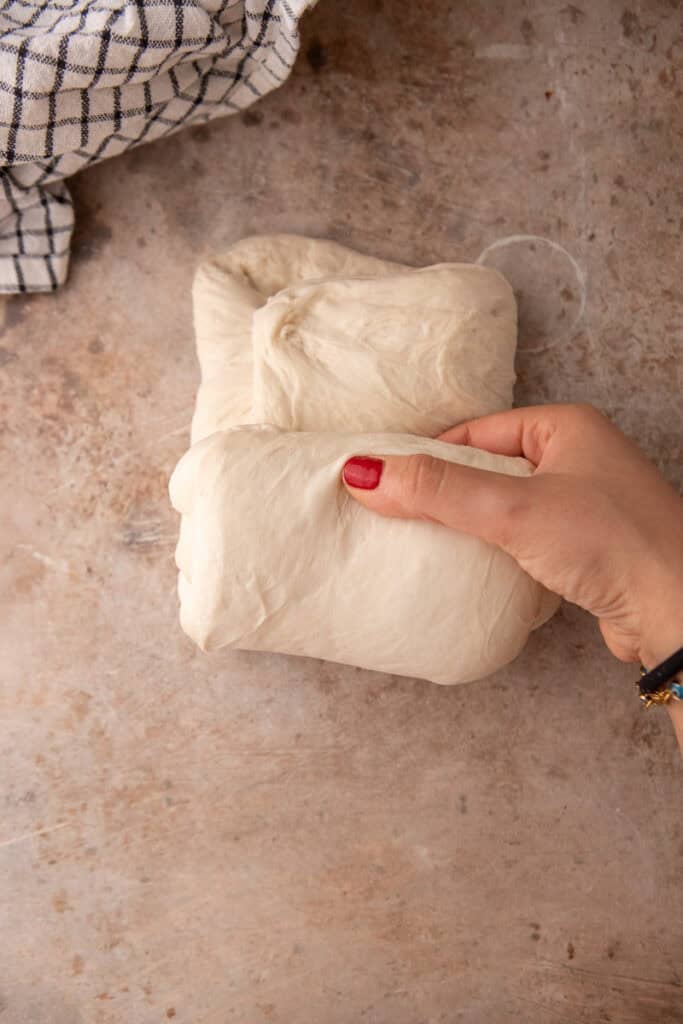
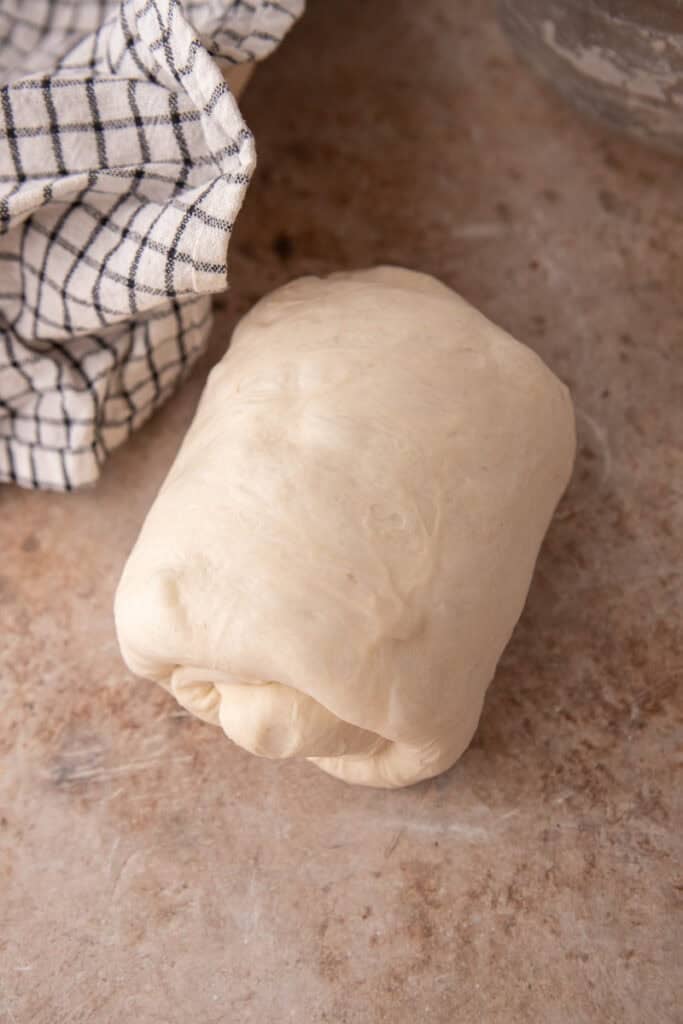
- Leave it seam-side down, cover with a damp kitchen towel or bowl, and let it relax on the counter for 30 minutes.
Final Shaping & Proofing
- Reshape the dough with a tighter structure to create surface tension by gently tucking the dough underneath and alternating with quarter turns until it’s tight.
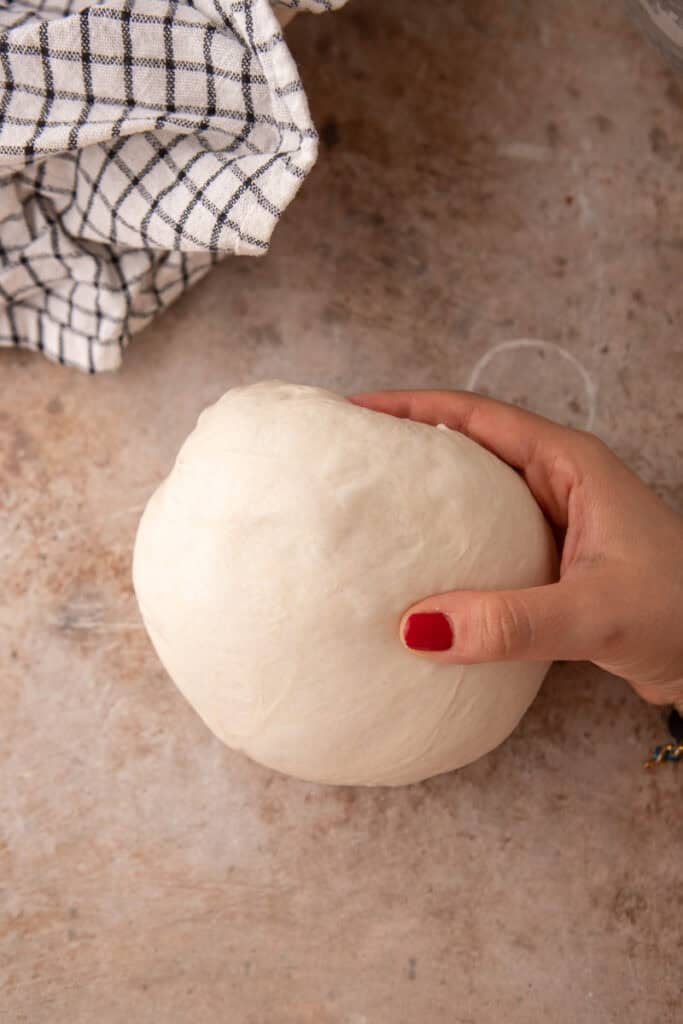
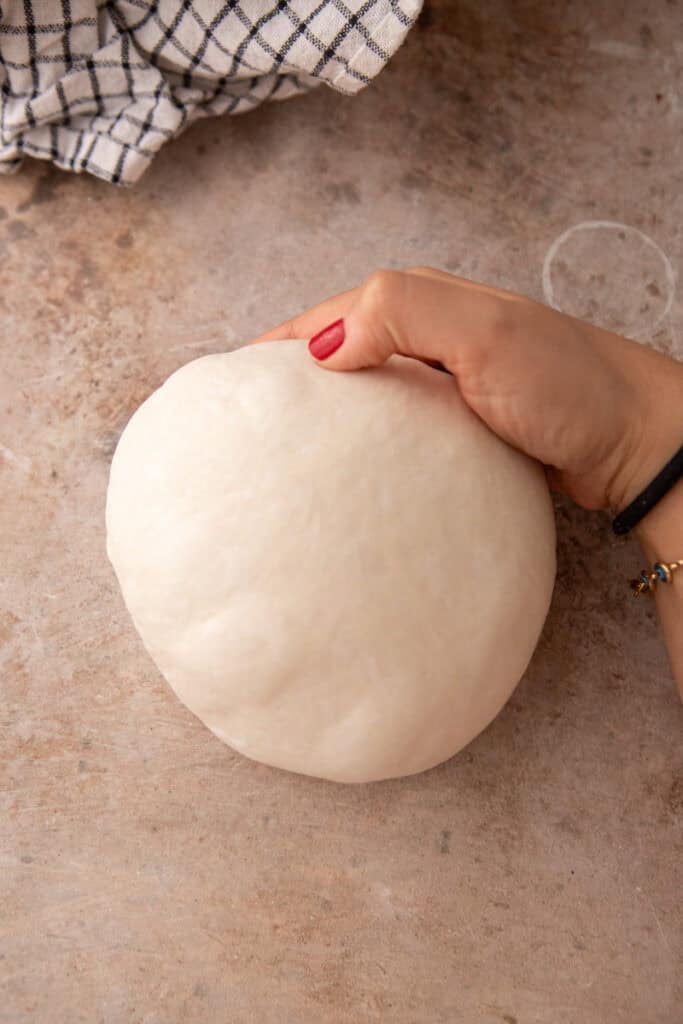
- Transfer it to a floured proofing basket or bowl, seam side up.
- Cover and proof in a warm spot on the kitchen counter until the bread dough slowly springs back when gently pressed. It should rise by about 50–75%.
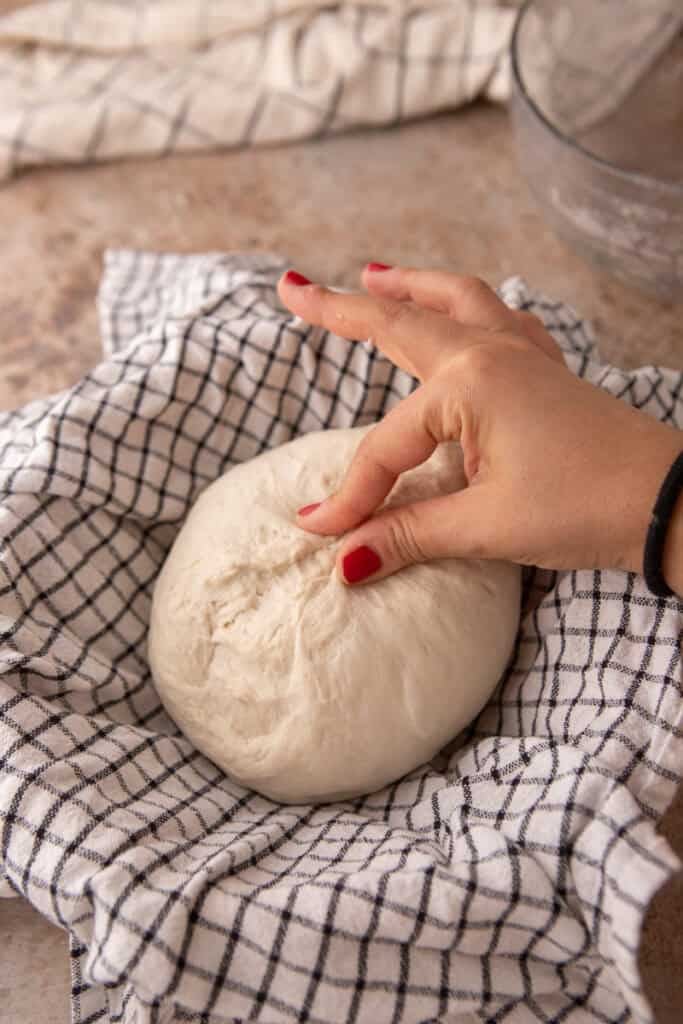
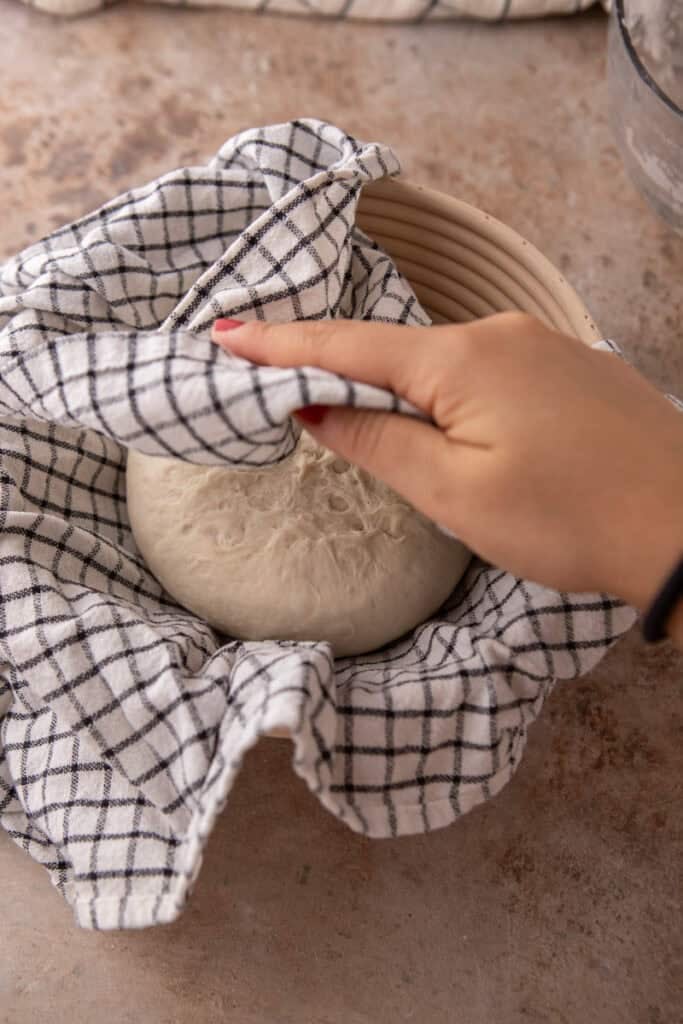
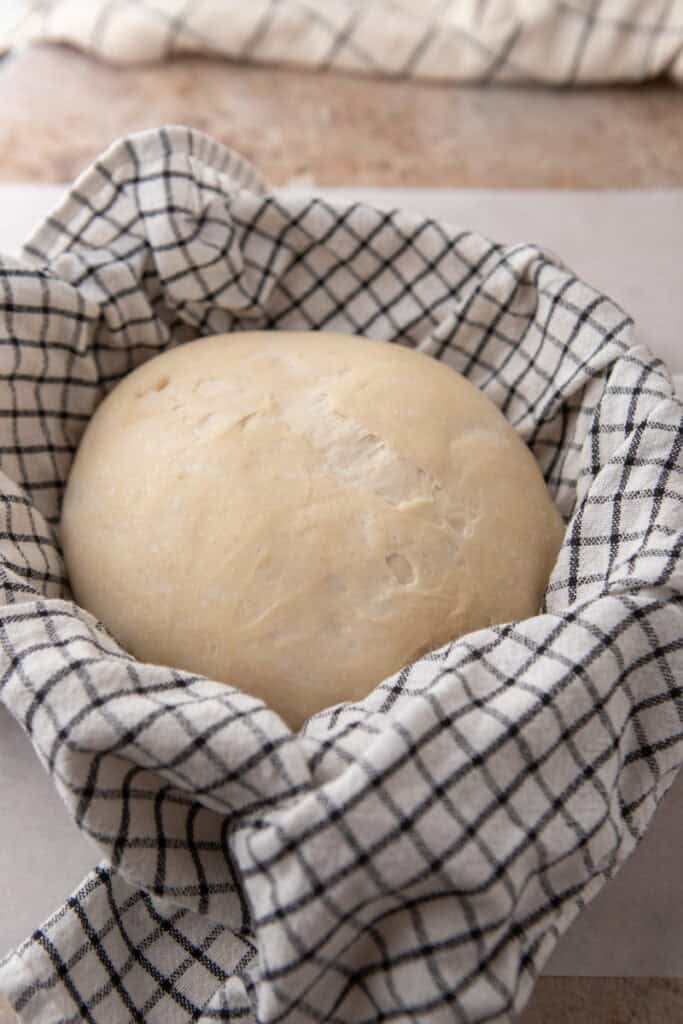
Bake
- Preheat your oven with a Dutch oven inside.
- Carefully flip the dough onto a piece of parchment paper, score the top with a razor blade or sharp knife, and lower it into the hot Dutch oven with a silicone bread sling or parchment paper.
- Bake in the hot oven with the lid on for 20 minutes. Then remove the lid, reduce the oven temperature, and continue baking until the crust is deeply golden brown.
- Let the loaf cool fully before slicing to maintain a soft, open crumb.
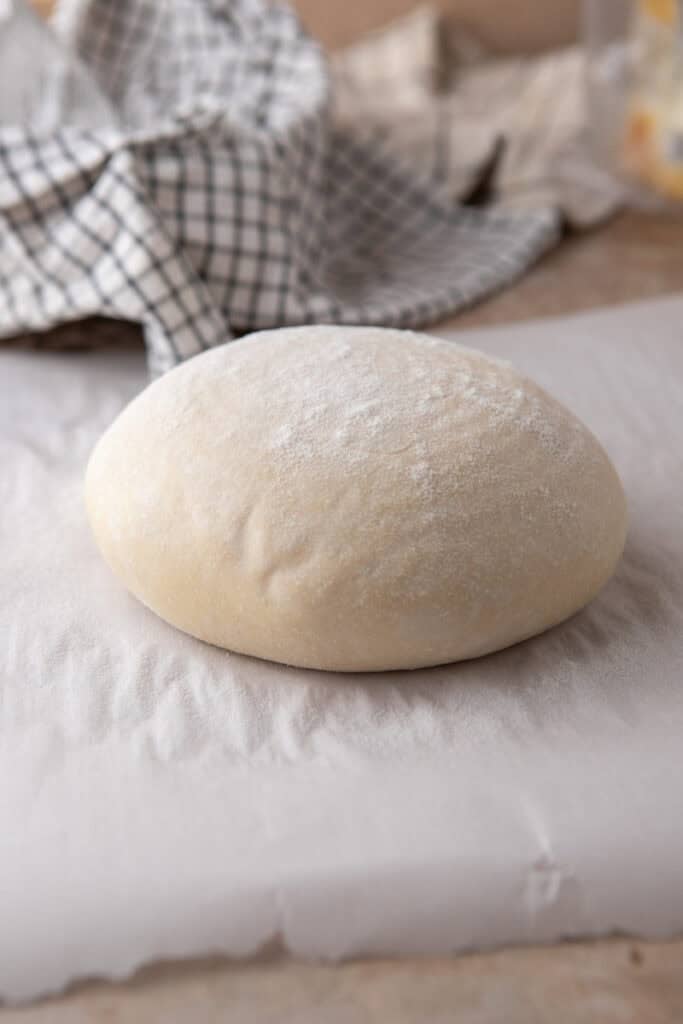
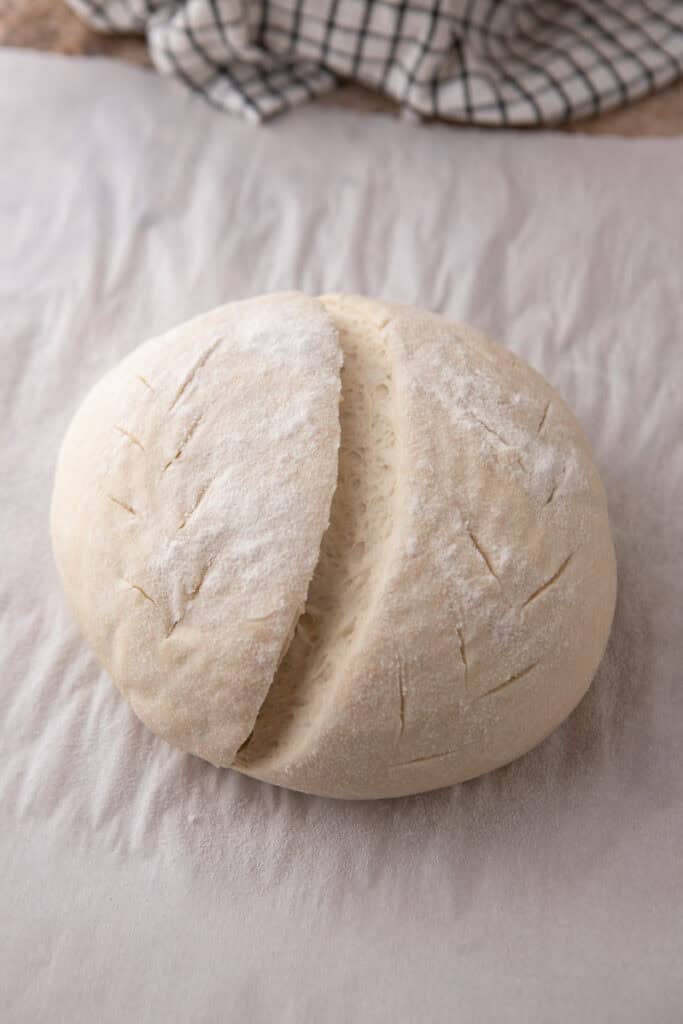
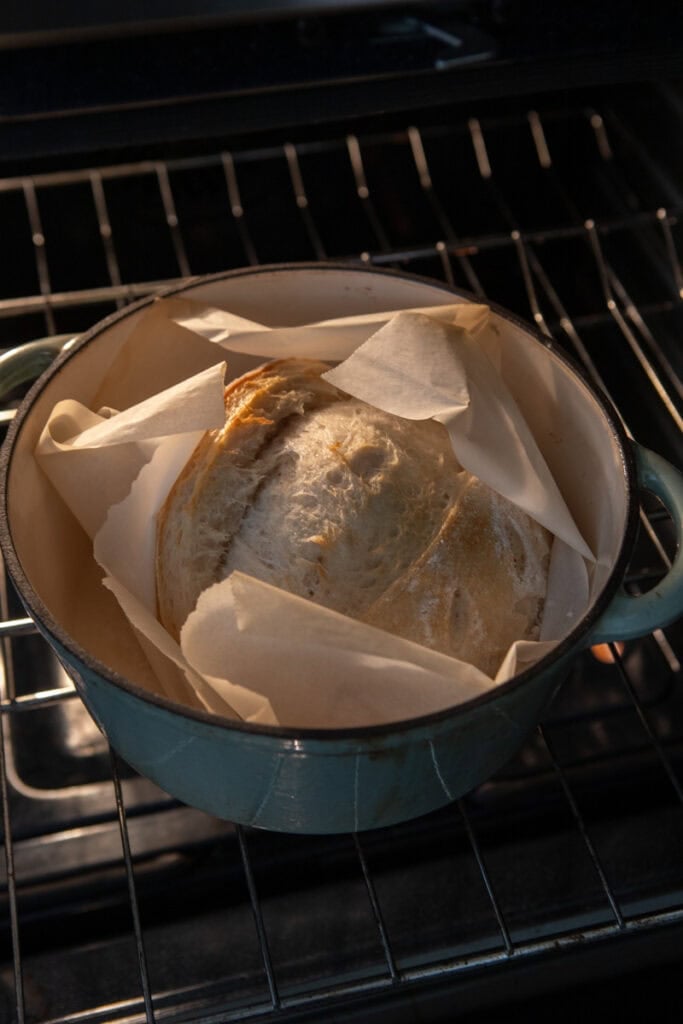
Simplified, Easy-to-Follow Schedule
- 9:00 AM: Fermentolyse begins: Mix flour, water, and starter until thoroughly combined
- 9:30 AM: Add salt and gently mix it in
- 9:45 AM: Start bulk fermentation
- 10:15 AM: First set of stretch and fold
- 10:45 AM: Second stretch and fold
- 11:15 AM: Third stretch and fold
- 11:15 AM – 1:15 PM: Rest dough to complete bulk fermentation (~50% rise)
- 1:15 PM: Pre-shape dough, cover, and rest on the counter
- 1:45 PM: Final shape and transfer to banneton basket
- 1:45 PM – 3:15 PM: Final proof at room temperature
- 2:45 PM: Preheat oven to 475°F with Dutch oven inside
- 3:30 PM: Score the top of the dough and bake
- 4:15 PM – 4:30 PM: Remove from oven and let cool completely on a wire rack
These times are estimates, so they will be different depending on when you start, your ingredient’s and kitchen’s temperature, and the speed at which you work. Keep a notepad near your work station or note your times on your phone to keep track of everything!
Enjoy this with some fresh butter or a warm bowl of this chicken and cabbage soup.
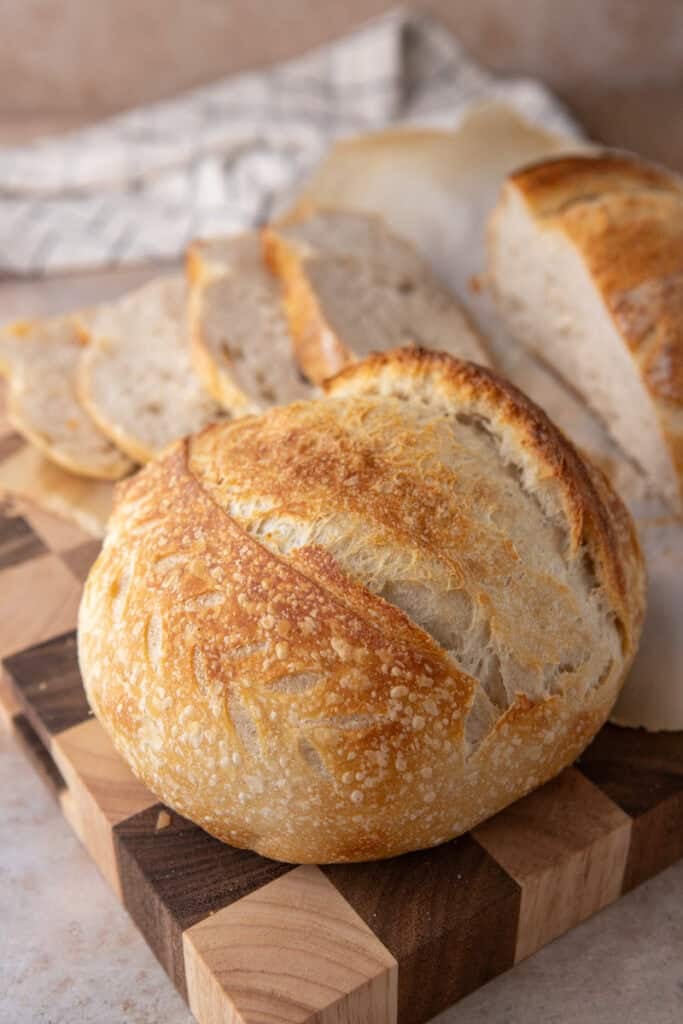
Same Day Sourdough Tips and Tricks for the best results
- Steam is important while baking. If using a Dutch oven with a lid, you’re fine. If you don’t have a lid, put a tray of boiling water in your oven during the first 20 minutes and then remove it.
- Use a kitchen scale instead of measuring cups to get the right amount of flour that you need with better accuracy.
- As always with sourdough, make sure your starter is well-fed and bubbly to know that it’s activated.
- Warm water is better for fermentation than cold water. If the temperature of your kitchen is on the cool side, use slightly warmer than room temp water to help keep fermentation on track. Also, make sure you’re using clean water.
- Be gentle when you perform the stretch-and-folds so you don’t tear the dough, and use wet hands to prevent sticking.
- During shaping, create surface tension on top by pulling the dough tightly underneath to help it rise upward instead of spreading.
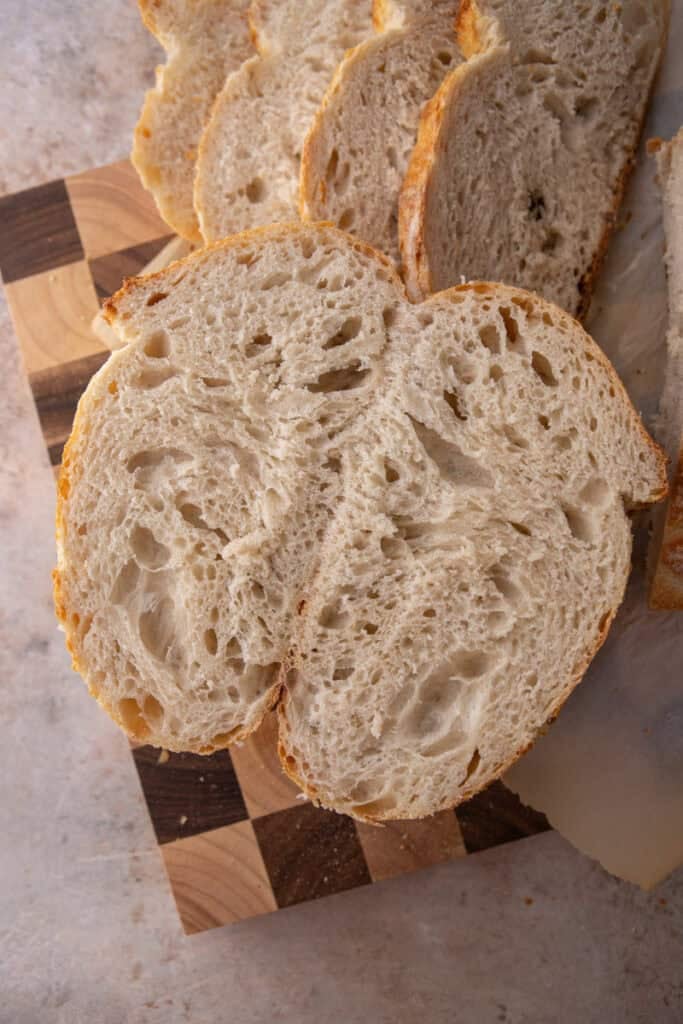
Why do you need to make this same day sourdough recipe?
- This easy recipe is a great option for every beginner baker to get their feet wet in making a whole loaf of bread.
- You no longer need to wait til the next day for hot and fresh sourdough bread.
- It’s very impressive to pull a warm, artisan-style loaf out of the oven. If you’re looking for a way to impress others on the day of an event, this is it.
- This recipe requires just four clean, wholesome, and simple ingredients.
- Making this sourdough loaf is better than other homemade bread because it uses wild yeast instead of commercial yeast, which creates a richer, more complex flavor.
- You can endlessly customize the flavor of this bread with an abundance of flavors!
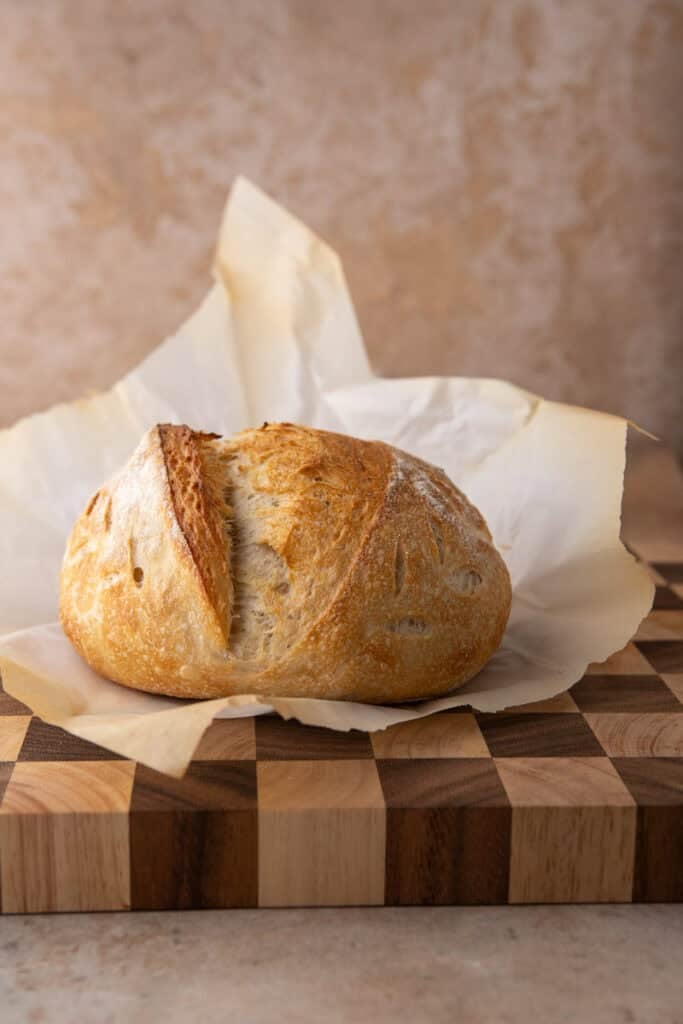
Frequently asked questions – FAQ
How long does this same day Sourdough bread take?
The whole process from start to finish takes about 8 hours. The best way to approach it (or at least what I do) is to start the recipe by 10 am at the latest in the morning, so it’s ready by 6 pm. This way it will be ready right in time for dinner, and you’ll be slicing fresh bread and serving it while it’s still hot on the table.
Why do we use bread flour?
Bread flour has a higher protein content, which means a better gluten development, which means you get a chewier bite. Higher protein and more gluten provides more elasticity for the interior dough to stretch and give better air bubble pockets. It’s a more enjoyable experience overall.
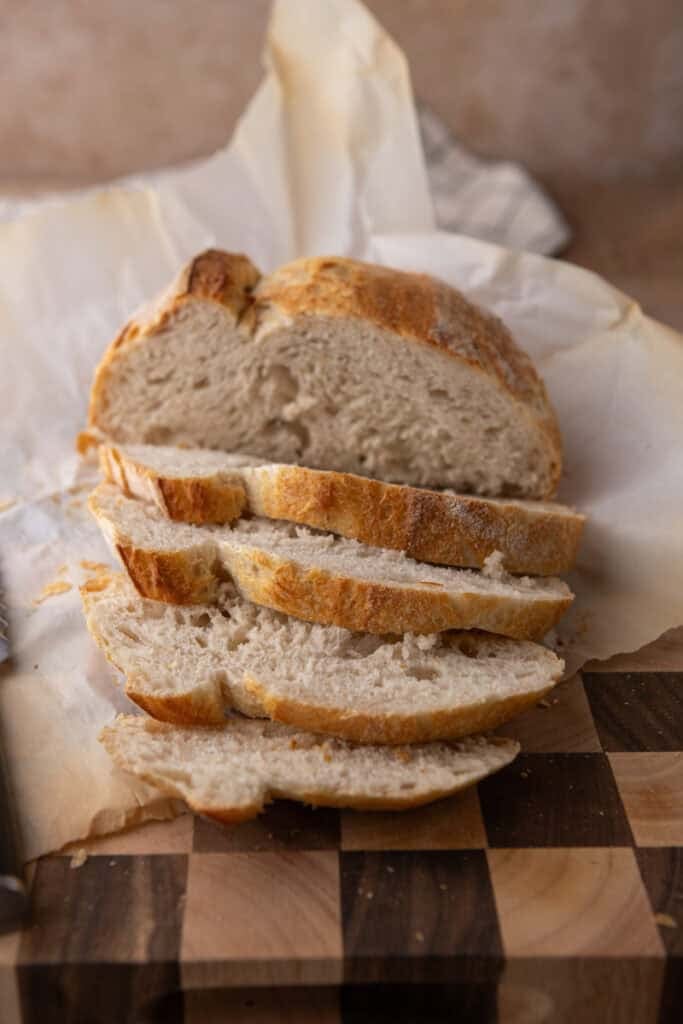
Can I use all-purpose flour instead for this same day sourdough bread?
All-purpose will work and still provide a decent loaf, but since this is a quicker sourdough bread recipe, bread flour is recommended. Bread flour has a higher protein content, which helps the gluten develop faster, giving you a better rise and texture. If you can, it’s worth using bread flour for best results.
Why is my dough not rising during the bulk fermentation?
Check the temperature and make sure it’s between 75 and 80 degrees F. If your kitchen is too cold, you can place the dough in a turned-off oven with the light on, or near a warm appliance to help it rise more effectively.
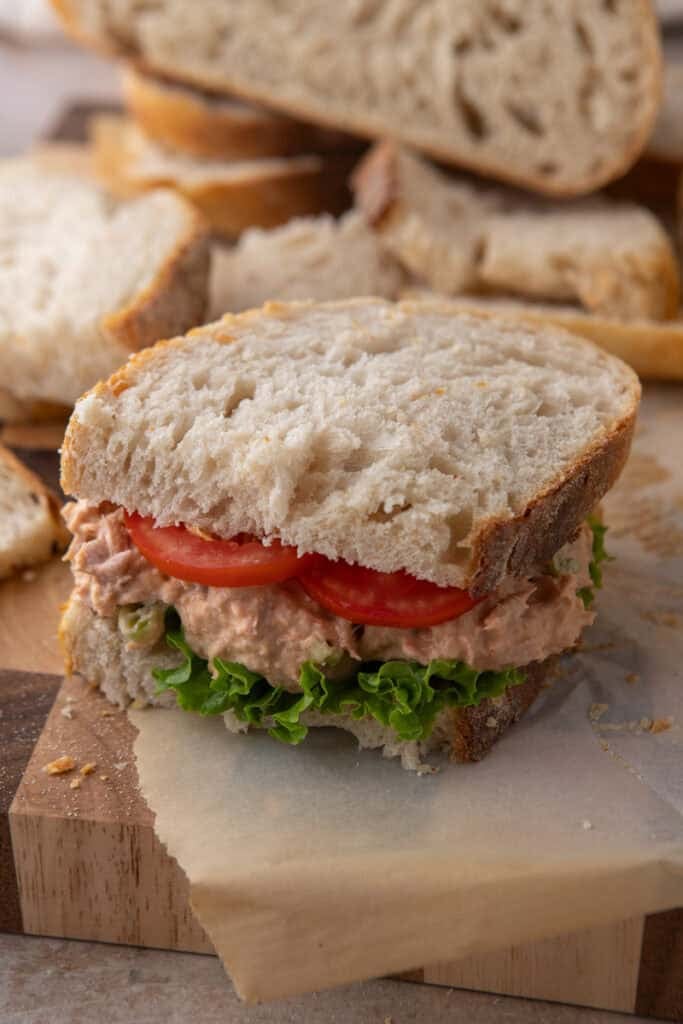
How do I know when the dough is ready to bake?
During final proof, the dough should look puffed and noticeably larger. An easy way to know if it’s ready is to use the poke test. If you gently press it with a finger and it springs back slowly, it’s ready. If it springs back too quickly, it needs more time. If it doesn’t spring back at all, it may be over-proofed.
Do I have to use a Dutch oven for the same day sourdough bread?
Not necessarily, but using a Dutch oven is probably the easiest way to get great results if you’re not a professional baker. The Dutch oven, trapped steam during the first part of baking, which helps create that perfect crust and airy crumb.
Without a Dutch oven, you need to get a bit more creative like using preheated steel pan and placing lava rocks at the bottom of your oven and adding water to create steam. These methods can work, but they’re more complicated and harder to get right for most home bakers. The Dutch oven makes sourdough bread, much simpler and more reliable.
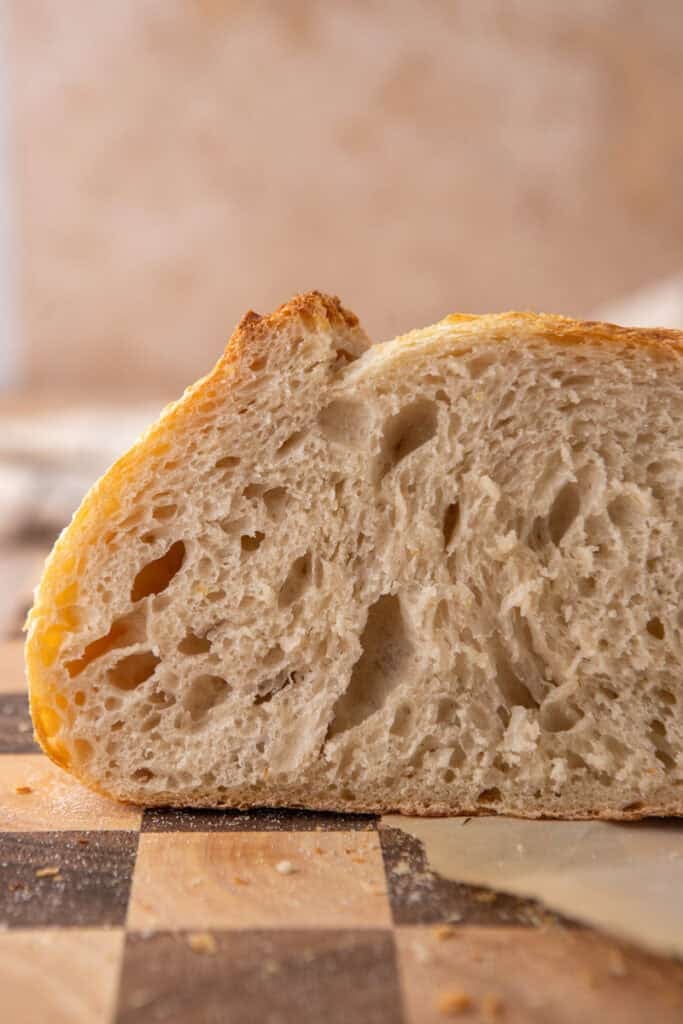
How do I store my leftover bread?
You can store it at room temperature for 3 days or in the fridge for up to a week in a paper or plastic bag. For longer storage, you can keep it in the freezer for about a month or two. To keep out the freezer air and to prevent freezer burn, you can wrap it in a layer of plastic wrap and aluminum foil.
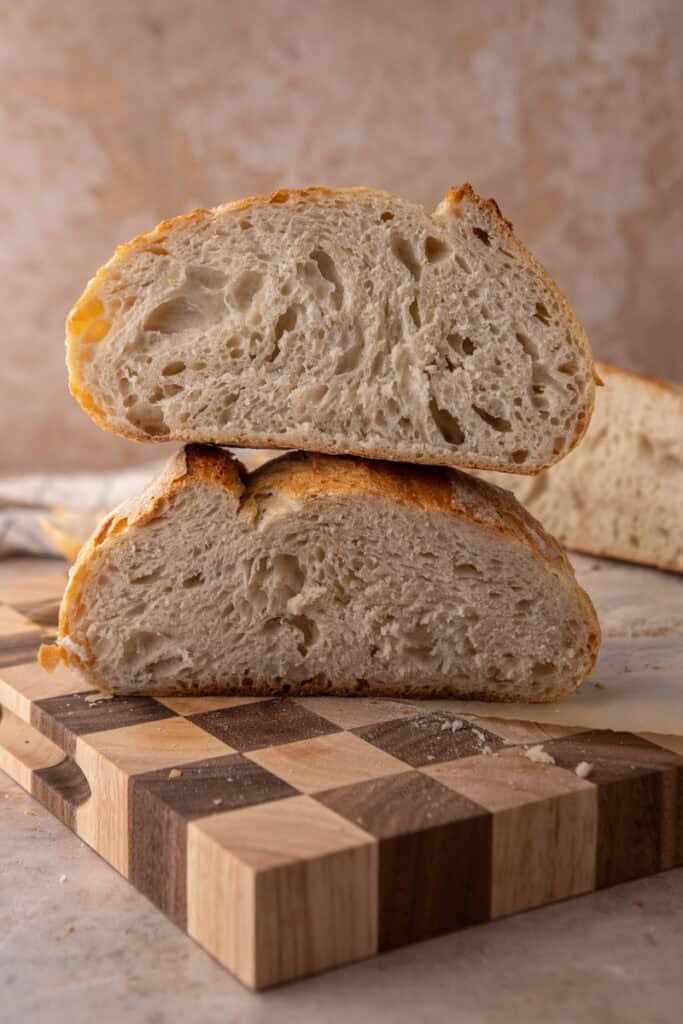
Can I add flavors to the same day sourdough bread?
Absolutely, I’d say that’s the best part about this recipe: the ability to play around with the different flavors! To flavor it, you could try using minced garlic, caramelized onion bits, chopped kalamata olives, shredded cheese, or nuts like pecans or walnuts.
You’ll want to add these mix-ins during the first stretch-and-fold so that they get incorporated throughout the other repetitions as well.
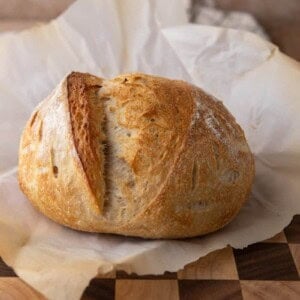
Same-Day Sourdough Bread Recipe
Ingredients
- 400 g Bread flour
- 280 g Water filtered
- 80 g Sourdough starter active, 100% hydration
- 8 g Salt
Instructions
Fermentolyse – 30 minutes
- In a large bowl, mix the flour, water, and starter together until no dry bits remain. Cover and let rest for 30 minutes.This activates enzymes, begins gluten development, and kickstarts fermentation.400 g Bread flour, 280 g Water, 80 g Sourdough starter
- Sprinkle the salt over the dough and knead it in gently using a stretch-and-fold motion or pinch method. Rest for 10 minutes to allow full absorption.8 g Salt
Bulk Fermentation (3.5 to 4 hours)
Keep the dough covered at warm room temp throughout this step (75–80°F if possible).
- Perform 3 sets of stretch and folds every 30 minutes for the first 1.5 hours. Pull each side of the dough up and fold over the center (north, south, east, west).
- Let the dough rest for the remainder of the bulk rise until it appears puffy and expanded by ~50%.
Pre-shape & Bench Rest (30 minutes)
- Turn dough out onto a lightly floured surface. Shape into a round (boule) or oval (batard). Cover and let rest 30 minutes on the counter, seam-side down.
Final Shape & Proof (1.5 to 2 hours)
- Shape again tightly. Place into a floured proofing basket or bowl (seam-side up).
- Cover and proof at room temperature until the dough springs back slowly when poked. Should rise by 50–75%.
Optional: Chill the dough in the fridge for a little before scoring it. (Makes it much easier to do!)
- Preheat oven to 450F with a Dutch oven inside. Flip the dough onto parchment paper, score, and carefully transfer to the hot Dutch oven.
- Bake covered for 20 minutes, then uncovered at 390F for 15-20 minutes until deep golden brown. The internal temperature should be between 200F-210F.
- Cool completely before slicing to preserve crumb structure.
Notes
Nutrition
Nutrition information is automatically calculated, so should only be used as an approximation.
